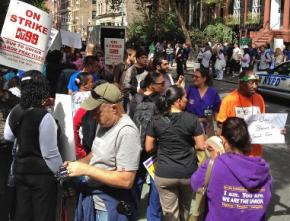Straus’ bullies won’t stop us
reports on the struggle for justice by nursing home workers--and the connections they are making with New York University student activists.
NEARLY 150 striking nursing home employees from Connecticut and New Jersey joined students, activists and community members at New York University (NYU) on September 11, delivering a message to HealthBridge owner and NYU "philanthropist" Daniel Straus that they intend to continue the fight for a fair contract until they get one.
Yet even as they rallied peacefully in defense of workers' rights and called for fair contract negotiations, activists were confronted by racist, sexist, anti-immigrant jeering and physical threats from a bunch of hired thugs.
The rally was organized by NYU's student-labor solidarity group, the Student Labor Action Movement (SLAM), to support members of 1199SEIU Healthcare Workers East in their ongoing struggle with HealthBridge/CareOne, a nursing home maintenance company overseeing facilities in New Jersey and Connecticut.
The company is co-owned by Daniel Straus, a member of NYU Law School's Board of Trustees and primary funder of the Straus Institute for the Advanced Study of Law and Justice at NYU. The Institute, established in 2009, serves to support "high-level research and scholarship on topics falling within a broad definition of law and justice."

Yet Straus' own business practices, which have granted him the ability to endow the Institute, are far from legal or just. HealthBridge has been engaged in a battle with 1199 in an effort to break the union's influence at its facilities after its membership refused to accept a series of cuts. HealthBridge/CareOne locked out employees at the West River, Conn., facility in the middle of December of this past year and refused to allow their union representatives back to the negotiating table until they agreed to an automatic pension freeze.
The company was intent on imposing a series of cuts to health coverage, sick days, overtime pay, holidays and an end to paid lunch breaks. In exchange, management offered a 12 percent pay increase over six years, which wouldn't come close to covering the resulting losses, amounting to over $70,000 during the life of the contract.
After nearly three months of resistance from the union and its membership, and a National Labor Relations Board ruling that deemed it unlawful, the lockout was ended, and nurses and other HealthBridge employees returned to work, though without a contract. The NLRB also issued statements condemning the company's actions at a Somerset County, N.J., facility, where workers who voted to unionize in 2009 were fired. Those workers have yet to get their jobs back, despite the ruling.
In early July, after another round of failed "negotiations," nearly 600 employees working in facilities across Connecticut and New Jersey went out on strike to protest the company's unwillingness to engage in substantive and productive negotiations that would give way to a contract SEIU members could agree to.
HealthBridge argues that SEIU is being unreasonable in an era of economic hardship. For the many who have seen this same card played for the past several years, however, it is clear that Straus and HealthBridge are using the economic crisis as a tool for extracting more wealth from its employees and weakening the power of their union in the name of fiscal discipline.
The union emphasizes that it signed fair contracts months ago at all facilities across New England except those owned and managed by HealthBridge. Further, the economic downturn didn't stop Straus from purchasing eight buildings on the Upper East Side in Manhattan last year, totalling around $95 million, which he plans on rebuilding for residential use despite local opposition.
TUESDAY'S MARCH began outside NYU's Elmer Bobst Library, where students and workers held a speak-out to air their grievances to the NYU community and to forge stronger connections with the student population, which has a material interest in supporting the ongoing struggle.
Caitlin MacLaren, a student activist and member of NYU SLAM, told a Washington Square News reporter, "Daniel Straus is trying to use the name of NYU to appear to be a philanthropist, and we really don't think he should be hiding behind the name of our university while at the same time breaking the law and treating workers unjustly."
Before continuing onto the Straus Institute, protesters made a quick stop in front of NYU's Law School, urging students to take note of the irony that a member of the Board of Trustees of their school is also a serial lawbreaker.
Outside the Institute, the peaceful protest turned ugly when the march encountered roughly 30 counter-protesters holding signs denouncing SEIU and SLAM in support of Straus. It was obvious right away that, although they were all wearing nurse's scrubs, few if any of them were employees of Straus or even nurses. This was hired intimidation.
When asked which nursing home they worked at, some pointed right behind them, at the Straus Institute! Others didn't even know what SLAM was, despite their signs denouncing it. The hired counter-protesters taunted activists, ripped up signs and banners, yelled homophobic slurs and threatened several people with physical violence if they refused to disperse.
Hours after the rally outside the Institute, Straus issued a press release denouncing SLAM and 1199SEIU, arguing that SLAM is a front group at NYU launched by SEIU as a part of their "campaign of misinformation and ruthless tactics revolving around a business dispute in Connecticut." "Perhaps SLAM should be asked about its connection to SEIU," he went on.
Contrary to this characterization of its origins, however, SLAM formed several months before workers at HealthBridge facilities were unlawfully locked out of nursing homes in Connecticut in December. Moreover, SLAM's aims go beyond simply Straus's HealthBridge.
After decades of the systematic weakening of the labor movement and the drastic rise in student debt and unemployment, undergraduate and graduate students at NYU formed SLAM last year, intending to foster "a natural alliance between students and workers" by engaging in labor struggles on and off-campus. Straus's illegal business practices have naturally been of great interest to SLAM.
SLAM's response to Straus and HealthBridge explained that "these actions underscore just how far Straus is willing to go in his campaign to slash the benefits of nursing home workers in Connecticut, and to prevent workers elsewhere from joining a union."
Despite the clear attempt at intimidating the burgeoning student-worker coalition at NYU, the message remained as clear and necessary as ever. The means by which Straus is getting his money--enabling him to buy up multi-million-dollar buildings in Manhattan and endow Institutes at NYU--is through exploiting workers. That exploitation isn't acceptable at NYU, or anywhere else.
It's also clear that NYU students, activists and SEIU members won't be intimidated by hired thugs and denunciations of genuine grassroots organizations here at NYU. The struggle only shows signs of intensifying--and the tactics being used by Straus and HealthBridge are feeding the flames of resistance, one goon at a time.


